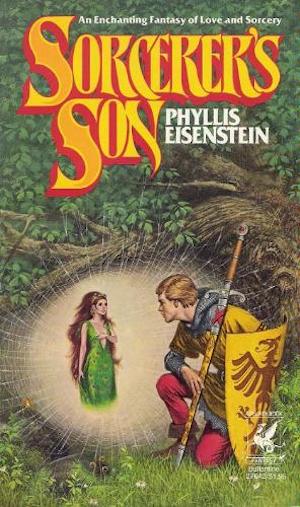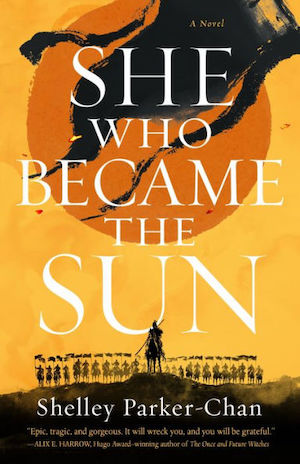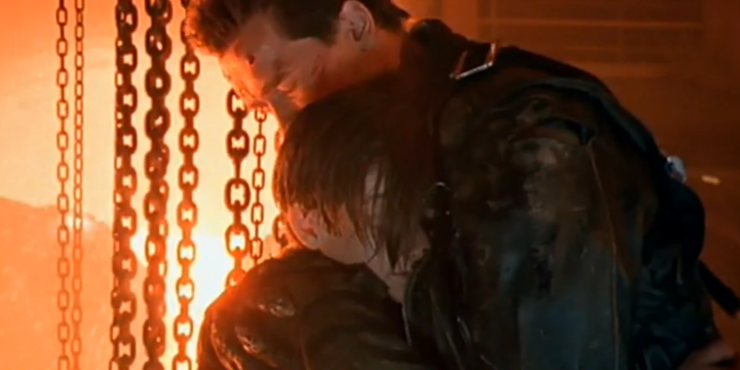I’ve read so many books, and I remember almost none of them. Plots, characters, worlds—they’re gone the moment I close the page. Just the other day my spouse asked me if I’d read any Bridgerton books, and I said quite confidently that I never had—only later to see that I’d written a review of one of them just the week before. I used to feel pretty bad about this! Surely if you were reading properly you were reading critically. How dare I say I liked a book if I couldn’t even remember what it was about?
Eventually, though, I cottoned onto the fact that I read fiction for the immediate emotional experience. If a story doesn’t stir an emotional reaction in me, it’s as if it doesn’t exist. Even for stories I’ve loved, sometimes all I remember is a certain tenor of emotion. A strength of feeling. Which is how it can be simultaneously true that one of the most fondly-remembered books of my childhood was also one that I’d forgotten entirely. I couldn’t remember the title, author, or even what it was about. But what I remembered was the figure of someone who had a male body, but was not male—a father who was not a man—and a powerful feeling of recognition and yearning. Somewhere in those forgotten pages, I had seen not just myself—but also something I wanted for myself.
I never looked for this forgotten book. I think we all know what it’s like to revisit childhood favourites, only to realise afterwards that we’ve overwritten cherished memories with our adult perspectives. But about two years ago I was browsing this very website, and I came across a piece by Elizabeth Bear about forgotten SFF classics of the 70s and 80s. And there, among other books I’d read and loved and forgotten (Vonda McIntyre’s Dreamsnake!), was the book. My book. Sorcerer’s Son, by Phyllis Eisenstein. How could I not re-read it, when the universe had offered it back to me like a gift? It came in the mail in exactly the same mass market edition I’d read all those years ago—the first, and presumably only, edition, from 1979—with close-set type on browned paper, and the smell of the library.
I braced myself for disappointment, and read.

Sorcerer’s Son is a classic quest-based high fantasy, set in a pseudo-medieval European world of knights, castles, sorcerers and demons. The hero, a young man named Cray who has been raised in protective isolation by his sorceress mother, ventures into the world to find the identity of his father who vanished before his birth. So far, so standard. But unlike much of modern YA, where the sole focus is on the young protagonist and their coming-of-age journey, Sorcerer’s Son tells another side of the story. So, let’s rewind. This story starts before Cray’s birth: it’s the story of two fathers. The straight father and the queer father; the annihilating, rage-filled biological father and the father of love, and choice.
Rezhyk is a self-centred, tyrannical sorcerer who enslaves demons to do his bidding. His first and most powerful slave is Gildrum: a bodiless fire demon he has forced into the physical form of a pubescent girl. When a sorceress rejects Rezhyk’s offer of marriage, he flies into a furious, paranoid delusion that she must plan him harm. He gives Gildrum a new mission and suitable body with which to carry it out: curtail the sorceress’ powers by impregnating her. Gildrum’s cynical mission goes awry when, after seducing the sorceress with his beautiful male body, he falls in love in return. But the demon is still a slave. Forced back to Rezhyk once the mission is complete, imprisoned once again in a girl’s body, Gildrum can only watch helplessly from afar as her son—Rezhyk’s biological son, but the son of Gildrum’s heart—becomes a man. As Cray pursues his quest, his path leads to Rezhyk’s castle. There, he unknowingly meets his two fathers: the cruel and violent man who desires both his and his mother’s death, and the girl-shaped demon who seeks to save them.
I closed the book in shock. I hadn’t remembered any of this. I hadn’t even retained the key detail that yearning, chained, demon dad Gildrum spends most of the book as a girl. The word ‘genderqueer’ didn’t exist until I was already well into my adulthood. And yet my child self had read this book, and recognised the clarion call of what it represented. I had been that genderless being trapped with my rage and grief in a girl’s body. Like Gildrum, all I’d wanted was to be free.
Probably, when I found Sorcerer’s Son, I would have already read other fantasy books that played with genderbending. Tamora Pierce’s Tortall series, certainly, with crossdressing knight Alanna, and L. Frank Baum’s trans princess Ozma. But Gildrum must have been the first truly genderfluid character I’d encountered. Gildrum’s pronouns are constantly in motion. When the demon wears a body that is seen as female, we read she; when male, he. But since the text explicitly states that the demon’s true form—a disembodied flame—is genderless, we know that this slippage only reflects human perceptions of the bodies the demon occupies, and nothing intrinsic to the demon itself. Even at the story’s conclusion, when Gildrum takes a final form—the male form beloved of his sorceress wife—and commits to performing a single human gender role as man and father, he wears that gender lightly: as a choice, made for the love of others.
Gildrum’s self is genderless, but the gendered nature of the body in which she spends the majority of the story is inextricably entwined with her status as a slave. Her girl body with its blonde braids—sculpted by hand by her master Rezhyk—is “small, slight, insignificant. He liked her thus near him, she thought, because the form befit a slave.” Despite their human appearances, Gildrum’s physical bodies are inhuman: unbreakable, invulnerable, and possessed of demonic strength. And so, although magically bound into obedience, she must be furthermore rendered unthreatening: funnelled into a shape that, in the eyes of her violently controlling male master, inherently symbolises servitude and submission. A girl. (It’s probably relevant to note that there are no non-white people in this world. Ah, fantasy in the ’70s!) And a girl’s body has other uses for a man. The repeated descriptions of Gildrum’s female body as childlike—as seemingly younger than her teenage son, Cray—darkly underscore what we glimpse in slices: that Rezhyk doesn’t hesitate to use that body sexually.
Girl-bodied demon Gildrum was clearly a forerunner of a much later character of my genderqueer heart: Cameron, that unstoppable, unhurtable killing machine in the shape of a high school girl, from Terminator: The Sarah Connor Chronicles. Demon and robot: inhuman characters whose selves, specifically by virtue of their inhumanness, escape the gender binary with an ease never afforded to human characters. Ungendered selves; gendered surfaces. These inhuman-girl characters provide a powerful fantasy: that within that slighted, underestimated external shell lies a being with a greater capacity for physical violence than any who might threaten it. Rather than a weakness, the disjoint between appearance and self is both shield and weapon. Violent assumptions, of smallness and fragility and harmlessness, rebound with fatal consequence: that girl you just threatened will pick you up by the neck with one hand, and crush it until you die.
For me at least, another part of the appeal of these characters is that neither Gildrum nor Cameron care that they’re perceived as female. They know they’re other, and that their otherness—their true selves—stands apart from their shapes. As a child and a young adult, I was deeply, wordlessly, ashamed to be perceived as female. Cameron, enviably, has no feelings at all. Gildrum does. But instead of shame or self-hate about being rendered female in the eyes of the world, what she feels is rage: at her enslavement in a body that is neither self nor (unlike her final male form) her choice.
Rezhyk utterly controls his domain—a literally impermeable brass castle—and those within it. His entitlement to his control comes from his belief of ownership: of the castle, which Gildrum built from empty ground at his command, and of Gildrum herself, who wears a body he made. Rezhyk’s narcissistic control of Gildrum is that of an abusive father: nothing infuriates him more than when she expresses her desire to be other than what pleases him. When she pleads with him to let her claim her masculinity, her fatherhood, her love for the sorceress, he denies that her deviant feelings are even possible. He controls her tongue so that she is unable to speak her truth; he threatens her with eternal imprisonment. To have built a girl, and have her refuse to be a girl, is unacceptable. And when faced with a softer target than a demon who can neither be hurt nor killed, Rezhyk’s wrath is annihilating. When it’s Cray who earns his paranoid displeasure, Rezhyk feels no compunction about ordering his murder. In the worldview of this abusive father, it is merely the unmaking of what he himself made—it is his right. Without putting too fine a point on it, let’s just say that my child self no doubt recognised this familial dynamic.
Buy the Book


She Who Became the Sun
Gildrum is a desperate, determined protagonist. Although magically bound to fulfill her master’s commands, she treads the narrowest of paths between technical obedience and outright defiance to create the means to her freedom. And when Cray—still ignorant of his connections to both his fathers—enters the castle as an apprentice, Gildrum finds her best means yet. Without Rezhyk’s knowledge, Gildrum teaches Cray the secrets of demon mastery that Rezhyk has withheld out of suspicion and paranoia—the secrets that, Gildrum hopes, will allow Cray to kill Rezhyk and free her. Even though still girl-bodied and magically prevented from voicing her identity as the man Cray’s mother loved, for the first time Gildrum is able to act as father to her son. But a question hovers over the endeavour: by learning the demon-enslaving skills of his biological father, is Cray destined to become like Rezhyk? Will power inevitably lead to his assumption of the patriarchal mantle of toxic rage and control?
When Cray kills Rezhyk, in what is framed as an act of self-defence against his biological father’s murderous rage, he assumes control of Rezhyk’s enslaved demons—including newly male-bodied Gildrum, who has just been reunited with Cray’s sorceress mother. Cray’s choice to free Gildrum becomes the choice of a new kind of family. A queer father replaces the hated straight father. In the last sentences of the novel, Cray steps into the welcoming arms of Gildrum and his mother. He assumes the child role once again, this time with the promise of all the love, protection and acceptance that were impossible before.
The chosen family of Sorcerer’s Son, with its genderless demon father, resembles another family I must have seen at about the same age: that of Sarah Connor, her son John, and the iconic T-800, in the movie Terminator 2. Like Gildrum’s family, the Terminator family resembles a heteronormative nuclear family on the surface. But the appearance of heteronormativity hides a deeper equality premised on a genderless father, and the absence of the toxicity and violence of homophobic straight masculinity. The inhuman strength of both Gildrum and the T-800, unconstrained by the patriarchy, is channelled instead into protection and nurturance. As Sarah says of the T-800’s fathering of John, “It would never leave him, it would never hurt him, never shout at him, or get drunk and hit him, or say it was too busy to spend time with him. It would always be there. And it would die, to protect him.”
As a child all those years ago, I must have looked at those families—looked at Gildrum and the T-800—and thought, while knowing it was impossible: I want to have that father. I want to be that father.
As an adult and parent myself—I still think that. But now, I know it’s possible.
Shelley Parker-Chan is an Asian-Australian former diplomat and international development adviser who spent nearly a decade working on human rights, gender equality and LGBT rights in Southeast Asia. Named after the Romantic poet, she was raised on a steady diet of Greek myths, Arthurian legend and Chinese tales of suffering and tragic romance. Her debut novel She Who Became the Sun owes more than a little to all three. In 2017 she was awarded an Otherwise (Tiptree) Fellowship for a work of speculative narrative that expands our understanding of gender. She currently lives in Melbourne, Australia, with her family.










